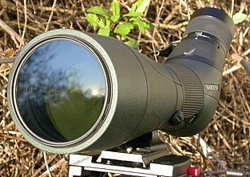Binoculars of 7x to 10x magnification are fine for birds that are close up or a moderate distance away. When needing greater magnification, for example to watch water fowl, birders use telescopes especially designed for birding. These birding telescopes, called spotting scopes, are different than the astronomical telescopes. Most of the design principles and optics are the same as in binoculars. But some design factors are unique to scopes. Most spotting scopes are monocular, their objective lenses are larger and barrels longer to accommodate higher magnification, most have interchangeable eyepieces, allowing you to choose one (or more) that fits your preferences. All birding scopes have a mounting plate to attach a tripod or other support device. Most have a sight to help line up the bird before looking through the eyepiece. Magnification: Birding scope magnifications range from 10x to 75x. To maintain image quality at high magnifications, highest quality glass and the largest objective lenses are needed. Also, very high magnification increases the likelihood of distortion from heat waves and scope movement, as these effects are magnified along with the image. Scopes range in price from about Rs 12,000 to over Rs 1,00,000 just for the bodies. Extra money is needed to buy a sturdy tripod that will properly support your scope. There are two basic body designs; straight and angled. With straight scopes, the barrel and the eyepiece have axes that are parallel, if not coincident. Straight scopes are easier to aim and lesser strain on neck. Angled scopes bend the light path so that the eyepiece is 45º from the barrel axis. Angled scopes are easier to share with a group. Telescope designs (refractor, catadioptric, and reflector) Refractor: Refracting telescopes use a lens as the objective at one end of a tube, an eyepiece at the opposite end of the tube, and an internal prism to lengthen the optical path and right the image. Nearly all birding scopes on the market today are refractors. Catadioptric: Catadioptric telescopes use both a lens and a mirror. Most catadioptric scopes have images that are vertically correct, but reverse the image left and right. This can be confusing when trying to follow a moving bird. Catadioptric scopes provide greater magnification than refracting scopes of the same weight, but are much costlier. Reflector: Reflecting telescopes use a mirror as the objective. As of today no current birding telescopes of this design is available in the market. Objective Lenses: The size ranges from 50-100mm. As noted on the binoculars page, objective lens size is the main indicator of image brightness, as that is dependent upon the amount of light falling on the objective. Larger objectives gather more light but weigh more. Generally speaking, for high magnifications, only 80+ mm scopes give acceptable performance in all light conditions. Coatings: The other main factor of image brightness is light transmission. To increase light transmission, manufacturers use special glass and coatings on lenses and prisms to reduce reflections. In most conditions the difference between the lower and higher priced glass is not noticeable but when light get low the expensive glass shows its worth. Eyepieces: Most scope makers offer a variety of eyepieces for their scopes. Some are designed to work on multiple scope lines and others specifically for each line. Nowadays zoom eyepieces rival fixed power eyepieces in sharpness and brightness. Zoom eyepieces allow birders to scan at low power, then crank up the magnification to get the most detail. Common magnifications are 15x, 20x, 22x, 27x, 30x-32x, and 50x. Some fixed eyepieces feature long eye relief, which is useful for eyeglass wearers and digiscoping. Digiscoping: The technique of attaching and using a combination of digital camera and a spotting scope is called Digiscoping. There are two ways to take photograph birds through a scope. The first uses a camera adapter to attach a 35mm SLR camera to the scope. This system has a fixed focal length and the camera's viewfinder is used as the eyepiece, and there is no way to change the aperture. Or, you can put a digital camera up to the back of your scope. In either case, you get best results with the largest possible objective lens, as it will gather the most light. |
|








